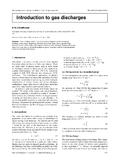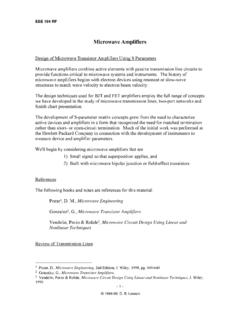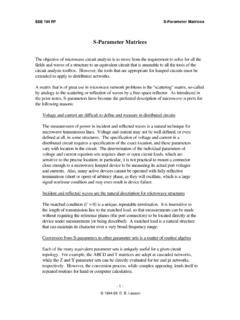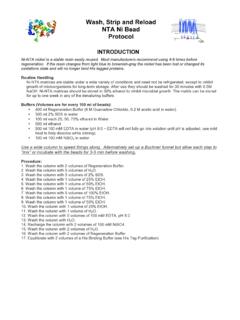Transcription of Waves and Impedances on Transmission Lines
1 EEE 194 RF TL Waves & Impedances Waves and Impedances on Transmission Lines Transmission line Circuit Model1. Consider a Transmission line consisting of iterated incremental elements as shown here: I. Z. Z = R + j L. V Y. Y = G + j C. Z and Y are the impedance and admittance per unit length ? z. Z = R + j L and Y = G + j C, where R is the series resistance per unit length ?z, /m L is the series inductance per unit length ?z, H/m G is the shunt conductance per unit length ?z, S/m C is the shunt capacitance per unit length ?z, F/m The equations for V and I are dV dI. = ZI and = YV, simultaneous solution of which yields dz dz d2 V d2 I. = ZYV and = ZYI; z here represents distance along the Transmission line .
2 Dz2 dz2. The solution of these equations is in the form of Waves in the +z and -z direction, which for sinusoidal excitation take the form V(z) = V+e t-j z + V-e t+j z) and I(z) = I+e ( t-j z)+ I+e ( t+j z). 1 This particular derivation is from Terman, Electronic and Radio Engineering, 4th Ed., McGraw-Hill, 1955, Ch. 4. -1- 1994-99 D. B. Leeson EEE 194 RF TL Waves & Impedances The propagation constant is given by = + j = ZY . For L>>R and C>>G (low or zero loss case), = LC. The voltage and current functions represent Waves in each direction such that successive peaks and troughs move at a velocity 2p v= = f , so = .. To distinguish it from the free-space wavelength nomenclature or o , the wavelength on a waveguide or coaxial Transmission line is often referred to as the guide wavelength g.
3 For a single wave solution in one direction, the ratio V(z)/I(z) is the same everywhere on the line , and is defined as the characteristic impedance Zo , which for a lossless line is a real number V+ Z L. Zo = = = , where L and C are the inductance and capacitance per unit length. I+ Y C. Thus we can rewrite the current equation as V+ V- I(z) = I+e ( t-j z) + I+e ( t+j z) = e j( t- z) - e j( t+ z). Zo Zo where the minus sign reflects the fact that the magnetic field, and hence the current, of the negative-going propagation is reversed compared to that of a positive-going wave. If both Waves exist, the instantaneous voltage or current as function of location is the sum of voltages or currents of both Waves .
4 The characteristic impedance Zo is the ratio of voltage to current of either wave independently, but not necessarily their sum. Transmission line Parameters If we consider an infinite lossless Transmission line , we can determine the inductance L and capacitance C per unit length from geometric field considerations. The three physical embodiments that are of interest are the two-wire Transmission line , the coaxial Transmission and the microstrip Transmission line (a simple parallel-plate approximation). -2- EEE 194 RF TL Waves & Impedances Parameter Two-wire Coaxial Microstrip . L ln (D/a) ln(b/a) T/W. p 2p p 2p . C W/T. ln(D/a) ln(b/a). In this table, D and a are the center-to-center spacing and wire radius of the two-wire line , b and a are the outer and inner radius of the coaxial line and T and W are the dielectric thickness and conductor width of the microstrip line .
5 For two-wire line , the expressions include the approximation cosh-1 (D/2a) ln(D/a) for D/2a >> 1. If we solve for Zo of coaxial and microstrip line , we have 377. Zo = ln(b/a) for coaxial line (note use of ln and log10 in different references), and 2p r 377. Zo T/W for microstrip line , ignoring fringing fields. r For microstrip, more accurate approximations available in the literature, and there is also a simple Macintosh program used in EE344 Lab that calculates Zo given r , T and W. a D. Parallel Wire line b W. a T. Microstrip Coaxial line -3- EEE 194 RF TL Waves & Impedances Matched Load If the Transmission is uniform and infinite, the wave in the +z direction will continue indefinitely and never return in the -z direction.
6 Zo +z Infinite Transmission line If the uniform Transmission line is truncated and connected instead to a lumped resistive load RL. = Zo , the entire +z wave is dissipated in the load, which has the same effect as if an infinite line of characteristic impedance Zo were attached at the same point. This matched impedance condition is a unique situation in which all the power of the +z wave is delivered to the load just as if it were an infinite Transmission line , with no reflected Waves generated in the -z direction. Zo +z Z = Zo Matched Termination Same as Infinite line Boundary conditions at a matched load are the same as for the infinite Transmission line . Transmission line Discontinuities and Load Impedances If the wave on a Transmission line of characteristic impedance Zo arrives at a boundary with different Zo , or at a discontinuity, lumped load or termination of Z ?
7 Zo , the single wave moving in the +z direction cannot simultaneously satisfy the boundary conditions relating V(z) to I(z) on both sides of the boundary. On one side of the boundary V(z)/I(z) = V+/I+ = Zo and on the other side V(z)/I(z) = (V++V-)/(I+-I-) = ZL. As in the case for a plane +z Zo -z Z Zo Mismatched Load Creates Reflected Wave -4- EEE 194 RF TL Waves & Impedances wave reflecting from a dielectric or conducting boundary, transmitted and reflected Waves are required to satisfy all the boundary conditions2 . Waves can exist traveling independently in either direction on a linear Transmission line . If a wave in the -z direction is formed by a complete or partial reflection of the +z wave by some discontinuity such as a lumped load of Z?
8 Zo , the two Waves are by definition coherent and an interference pattern will exist. Even though the Waves are traveling in opposite directions, the interference pattern will be stationary with respect to the point of reflection, and will thus be a standing wave such as may be found on the strings of musical instrument (of course, these are also defined by a wave equation). The standing wave interference pattern is present both in the resulting V(z) and I(z). Visualization of Standing Waves The following set of graphs show the development of the reflected wave, beginning with an initially advancing incident wave moving to the reader's right, which is just about to reach the load point of reflection.
9 For these graphs, Zo =50? and ZL=100? . In the next graph, the incident wave has reached the point of reflection, and the reflected wave can be seen to be moving back to the reader's left. In this picture, the waveforms add to a greater magnitude. 2 Pozar, D., Microwave Engineering, 2nd Ed., J. Wiley, 1998, Ch 2. -5- EEE 194 RF TL Waves & Impedances The reflected wave advances further to the left. In this picture, the Waves are subtracting. Once the reflected wave has reached steady state and moved off the left of the picture, we can look at the envelope of the combined waveforms. We see that, being coherent, they interfere and form a standing wave, with the voltage maximum at the point of the mismatched load ZL=200?
10 -6- EEE 194 RF TL Waves & Impedances Using the voltmeter function of the software, we can measure the peak as V, and in the next ..the minimum as V. Hence the ratio of peak to minimum is 2, which is the SWR, the standing wave ratio. This is real number, and does not vary with location on the line . -7- EEE 194 RF TL Waves & Impedances The Complex Reflection Coefficient . We can express the total voltage and current resulting from Waves traveling in both directions: V(z) = V+e j( t- z)+V-e j( t+ z), and V+ V- I(z) = e j( t- z) - e j( t+ z). Zo Zo A mismatched load may be either a lumped impedance or an infinite Transmission line of a different Zo . If we consider a complex load impedance ZL terminating a Transmission line Zo , the magnitude of the -z wave is related to that of the +z wave at the termination by a complex quantity defined as the reflection coefficient L, defined such that V- = LV+, where V- -I- L = = = | L|e j = e j = /.










